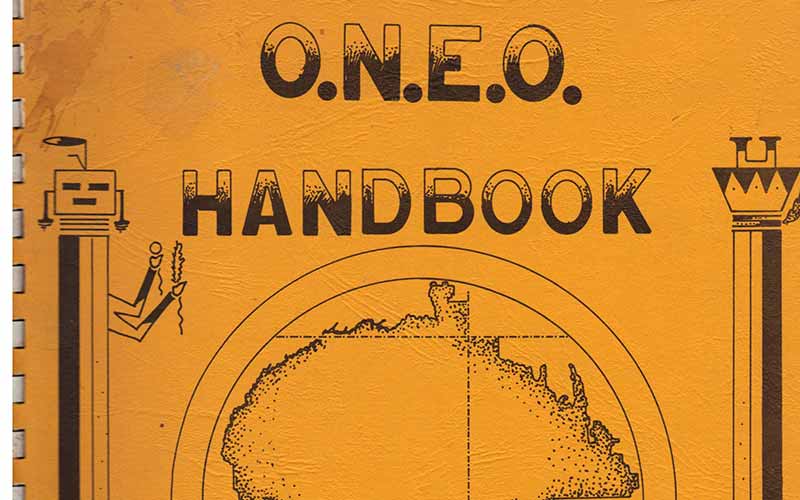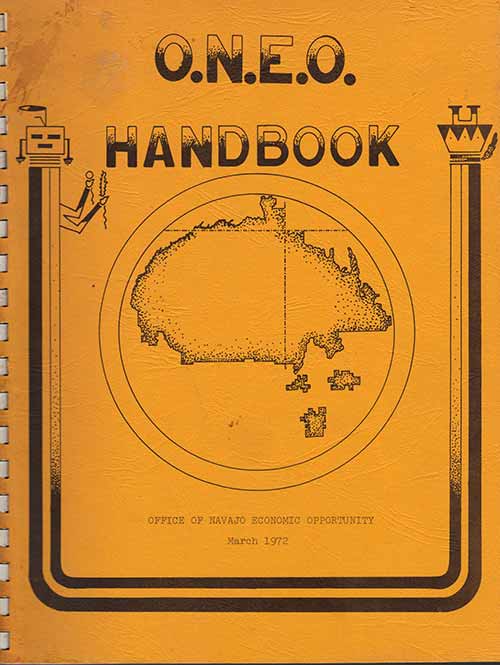
50 Years Ago: Nakai ponders possible candidacy of MacDonald


Office of Navajo Economic Opportunity Handbook, found for sale on Amazon.com
As 1967 was coming to a close, Navajo Tribal Chairman Raymond Nakai began realizing he had a problem and that centered on the head of the Office of Navajo Economic Opportunity – Peter MacDonald Sr.
Dick Hardwick, who was assigned by the BIA Navajo Area director to temporarily run the Navajo Times, said in an interview in the early 1970s that a couple of months after he took the position he began hearing reports that MacDonald may make a bid to become chairman in the 1970 election.
If Hardwick was hearing these rumors, it’s likely that Nakai was also and he would take steps to minimize the threat. Hardwick said he remembers receiving a call from one of Nakai’s aids shortly after the paper ran an article about MacDonald asking him who has asked him to put it in the paper.
Hardwick said he had received a press release and decided it was worth publishing. The aide said all right and then hung up.
A short time later, probably no more than a month or two, Hardwick said he received another phone call from this same aide after another article about MacDonald appeared in the paper and the same dialogue occurred – who had told Hardwick to publish the story and Hardwick replied no one had and it was a press release and he had made the decision on his own to publish it.
Hardwick said the people in Nakai ‘s office appeared to be paranoid about the possibility that MacDonald would run for chairman in 1970.
What Nakai wanted was to again face off against Sam Billison, who he had defeated in 1966. Although Billison had been quoted in articles published in the Gallup Independent and the Farmington Daily Times saying things critical of his administration, Nakai wasn’t worried.
Nakai knew that in 1970, he would continue to have the backing of members of the Native American Church because of his efforts to change tribal laws to allow members the right to use peyote in their ceremonies.

Navajo Times/Paul Natonabah
Navajo Nation President Peter MacDonald (1970-1989) walks away from one of his hearings with his wife, Wanda, guarded by Navajo Nation police.
And he also believed that the NAC had a lot of members on the reservation. In the 1970s, NAC officials were saying that more than a third of the tribe’s adult members were attending at least a couple of NAC ceremonies a year.
With the NAC’s backing, Nakai and his staff thought anyone who challenged him would have a hard time winning but they also knew that Nakai’s popularity among non-NAC members was questionable, given the state of tribal politics at the time.
They also knew MacDonald was making a big impression with his ability to bring government services to low-income families on the reservation which, in 1967, meant most of the population.
This would give MacDonald a base to work off of and the fact that he was starting to get press in the Navajo Times and in the off-reservation papers meant that he was being looked on as a possible contender for the chairmanship spot.
MacDonald hadn’t said he was interested in running but some of Nakai’s aides thought it was only a matter of time.
At the time, most tribal members thought Billison would run again because of his continued efforts to slam the Nakai administration in the press and in speeches at chapters. And Billison himself was indicating that he was strongly considering running again.
The worse case scenario in Nakai’s eyes was a situation where Billison would decide not to run and would support MacDonald, giving MacDonald two strong political bases to take into the election.
Another factor was the belief that any candidate who ran on platform of making changes in the tribal government would get a lot of support.
After all, Nakai himself had spent years before he was elected critiquing the tribal government and saying it was time for a change. So the idea of someone else coming forward with the same premise would gather support among tribal members who for one reason or another didn’t like what they saw going on in the tribal government.
Nakai probably wasn’t worried about the youth vote since young Navajos had never made much of an impact in previous tribal elections. In fact, the major segments of the tribe’s population who voted in great numbers were the elderly and veterans and the key to winning was sill coming up with a platform to appease them.
Hardwick, in interviews later, said he wasn’t worried about being fired by Nakai since when he came over from the BIA to run the tribal paper, everyone knew what the tribe and the BIA wanted was to stay away from controversy.
When he came across a story that could be controversial, he said he would often alert off-reservation reporters and let them do the first stories on the matter. In many cases, this would allow him to cover the issue, making sure that he had Nakai’s position in the article.
Looking at the Times in Hardwick’s fist two years as managing editor, the tribal government was still considered the publisher and one could get the sense he was holding back and that off-reservation papers, and most notably the Gallup Independent, were providing a better coverage of the major issues affecting tribal members.
But this may have been good since Hardwick’s approach didn’t seem to be hurting the paper’s circulation – it was at about 12,000 a week during 1967 and 1968 – and the paper’s staff did not have to worry, as they did in the past, about the chairman’s office firing the editor.
But Hardwick said he knew all of this could change as the 1970 election got closer.
To read the full article, pick up your copy of the Navajo Times at your nearest newsstand Thursday mornings!
Are you a digital subscriber? Read the most recent three weeks of stories by logging in to your online account.








 Highway 264,
Highway 264, I-40, WB @ Winslow
I-40, WB @ Winslow